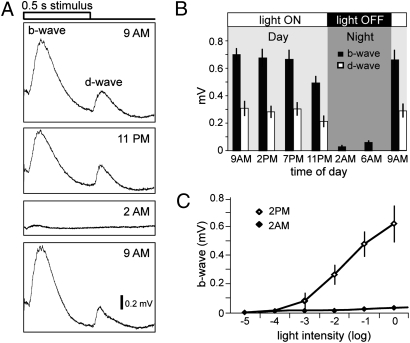Fig. 1.
Larval zebrafish exhibit a day/night cycle of visual responsiveness. (A) Representative ERG recordings to a 0.5 second white light stimulus are shown at four different time points: at 9:00 AM, when the ambient lights are turned ON; 11:00 PM, shortly before the lights are turned OFF; 2:00 AM, after the lights have been OFF for 3 h; and at 9:00 AM the next morning, after the lights are turned ON again. Note the large reduction of ERG amplitudes at 2:00 AM. (B) Average ERG b- (black bars) and d-wave (white bars) amplitudes taken at different time points over a 24-h period (n = 15 fish for each time point; bars indicate SD). (C) V-log I curves showing that increasing the light stimulus intensity at 2:00 AM did not increase the ERG amplitudes significantly. Average b-wave amplitudes in response to 5 log units of white light stimulus intensities at 2:00 PM and 2:00 AM (n = 5 fish for each time point).

